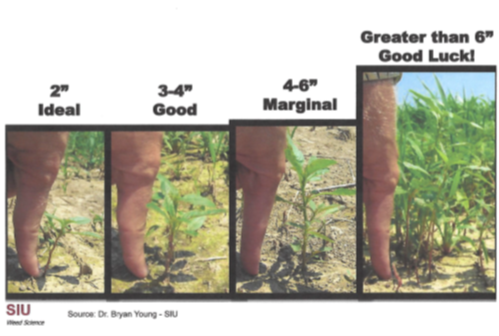
A year ago in March, I wrote my article about herbicide resistant weeds in Wisconsin. This article included:
- A time line of 35 years: 1979-2014
- The documented resistant weed species
- Herbicide families the weeds had resistance to
- The counties where these weeds were found
Did anything change in 2015? Well let’s talk about it, but keep in mind that the rest of this article does not include the whole state of Wisconsin, it is in reference to the area that WS Ag Center takes care of.
Lafayette County was not mentioned last year for herbicide resistant weeds in my article, but to answer the question: “Did anything change in 2015?” Yes it did! I did find a field in southwest Lafayette County with glyphosate resistant tall waterhemp. I had a customer call me after he had sprayed his soybeans and was concerned about his poor weed control, glyphosate was the only herbicide in the tank. When I looked at the field, some of the waterhemp plants were showing signs of herbicide injury while others were not. I sent samples of the healthy plants to the University of Illinois Plant Clinic, the results came back testing positive for glyphosate resistance and negative for PPO resistance, this lab runs both tests at the same time. Turn- around time for my test results was eight days, the lab will guarantee a two week turnaround time. WS AG Center did have similar situations with four different customers last year in regards to tall waterhemp. Their soybean fields were sprayed with glyphosate only and the waterhemp did not die. These fields were then treated with a different herbicide to work on the escaped waterhemp. The challenge with this scenario is that waterhemp is a very fast growing weed, .75 to 1.25 inches per day, so when you finally realize the glyphosate is not working, the waterhemp is a lot taller, making it much more difficult to control. We all know smaller weeds are easier to control. Dr. Brian Young from Southern Illinois University has a nice chart showing “ideal” to “good luck” pictures in regards to the height of waterhemp for herbicide timing and control, I included these pictures for future reference. I mentioned earlier that waterhemp is a very fast growing weed, as it gets taller it also has more growing points above ground. With more growing points to deal with, when applying different herbicides to glyphosate resistant waterhemp, coverage is key to make sure you get complete control of the waterhemp. I included a picture that does a great job showing the growing points on waterhemp plants.
In summary, Lafayette County does have both glyphosate resistant and non- resistant waterhemp. So as the 2016 season progresses, let’s keep that in mind. If you see poor performance from your glyphosate application in 2016, please call your WS AG Center agronomist to check your field, and figure out why the glyphosate application failed.
Thank you, Dan Langkamp